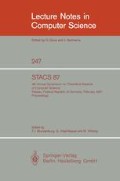Abstract
As a natural extension of P and NP, the Boolean closure of NP has attracted much attention recently. Many interesting properties of the class BH were discussed in [CH86] and [Wag85].
In this paper, we show that a random oracle A separates the Boolean hierarchy into an infinite hierarchy, i.e.
with probability one.
The proof technique is a combination of the “sawing” argument introduced in [CH86] and the method of Bennet and Gill [BG81] to handle the base case.
Research supported by a Sage Fellowship and NSF grant DCR-8301766.
Preview
Unable to display preview. Download preview PDF.
References
Klaus Ambos-Spies. Randomness, relativization, and polynomial reducibilities. In Structure in Complexity Theory, pages 23–34, Springer-Verlag Lecture Notes in Computer Science #223, 1986.
C. Bennet and J. Gill. Relative to a random oracle A, P A ≠ NP A with probability 1. SIAM J. on Computing, 10:96–113, 1981.
J. Cai. With probability one, a random oracle separates PSPACE from the polynomial-time hierarchy. In STOC, pages 21–29, 1986.
J. Cai and Lane A. Hemachandra. The Boolean hierarchy: hardware over NP. In Structure in Complexity Theory, pages 105–124, Springer-Verlag Lecture Notes in Computer Science #223, 1986.
J. Cai and G. Meyer. Graph minimal uncolorability is D P-complete. SIAM Journal on Computing, 1986. To appear.
H. Heller. Relativized polynomial hierarchies extending two levels. Mathematical Systems Theory, 17:71–84, 1984.
S. A. Kurtz. On the random oracle hypothesis. In STOC, pages 224–230, 1982.
C. H. Papadimitriou and D. Wolfe. The complexity of facets resolved. In FOCS, pages 74–78, 1985.
C. H. Papadimitriou and M. Yannakakis. The complexity of facets (and some facets of complexity). In STOC, pages 255–260, 1982.
K. Wagner. On the boolean closure of NP. In Proc. of the 1985 International Conference on Fundamentals of Computation Theory, pages 485–493, Springer-Verlag Lecture Notes in Computer Science, 1985.
K. Wagner. More complicated questions about maxima and minima, and some closures of NP. In Prod. of ICALP '86, Springer-Verlag Lecture Notes in Computer Science, 1986.
G. Wechsung. More about the Closure of NP. Technical Report TR N/85/43, Friedrich-Schiller-Universität, December 1985.
A. Yao. Separating the polynomial-time hierarchy by oracles. In FOCS, pages 1–10, 1985.
Y. Yesha. On certain polynomial-time truth-table reducibilities of complete sets to sparse sets. SIAM Journal on Computing, 12(3):411–425, 1983.
Author information
Authors and Affiliations
Editor information
Rights and permissions
Copyright information
© 1987 Springer-Verlag Berlin Heidelberg
About this paper
Cite this paper
Cai, Jy. (1987). Probability one separation of the Boolean hierarchy. In: Brandenburg, F.J., Vidal-Naquet, G., Wirsing, M. (eds) STACS 87. STACS 1987. Lecture Notes in Computer Science, vol 247. Springer, Berlin, Heidelberg. https://doi.org/10.1007/BFb0039602
Download citation
DOI: https://doi.org/10.1007/BFb0039602
Published:
Publisher Name: Springer, Berlin, Heidelberg
Print ISBN: 978-3-540-17219-2
Online ISBN: 978-3-540-47419-7
eBook Packages: Springer Book Archive

